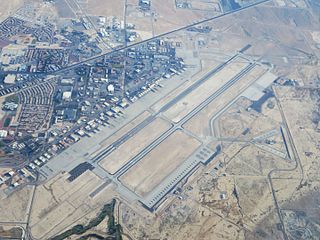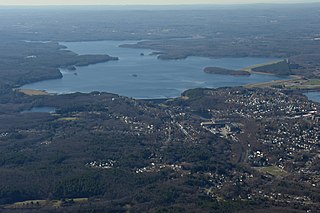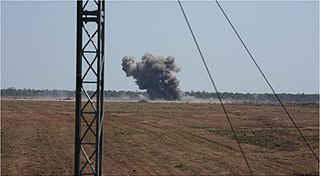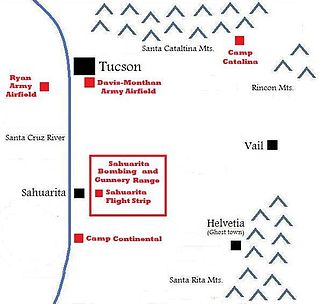Related Research Articles

Nellis Air Force Base is a United States Air Force installation in southern Nevada with military schools and more squadrons than any other USAF base. Nellis hosts air combat exercises such as Exercise Red Flag and close air support exercises such as Green Flag-West flown in "Military Operations Area (MOA) airspace", associated with the nearby Nevada Test and Training Range (NTTR). The base also has the Combined Air and Space Operations Center-Nellis.

The Quabbin Reservoir is the largest inland body of water in Massachusetts, and was built between 1930 and 1939. Today, along with the Wachusett Reservoir, it is the primary water supply for Boston, some 65 miles (105 km) to the east as well as 40 other communities in Greater Boston. It also supplies water to three towns west of the reservoir and acts as backup supply for three others. By 1989, it supplied water for 2.5 million people, which was about 40% of the state's population at the time. It has an aggregate capacity of 412 billion US gallons (1,560 GL) and an area of 38.6 square miles (99.9 km2).

RAF Holbeach also Air Weapons Range Holbeach, is a United Kingdom Ministry of Defence academic air weapons range (AWR) situated between Boston and King's Lynn near Gedney Drove End on The Wash, in Lincolnshire, eastern England. Most of the range, including the control tower and four observation towers (Quads) are in Gedney, but it does overlap with Holbeach to the west. On UK Civil Aviation Authority issued aeronautical charts the military Danger Area is found marked and identified by the code WRDA D207/II or the ICAO code EG D207, the danger altitude is usually up to twenty-three thousand feet AMSL.

The Wachusett Reservoir is the second largest body of water in the state of Massachusetts. It is located in central Massachusetts, northeast of Worcester. It is part of the water supply system for metropolitan Boston maintained by the Massachusetts Water Resources Authority (MWRA). It has an aggregate capacity of 65 billion US gallons (250,000,000 m3) and an area of almost 7 square miles (18.2 km²). Water from the Wachusett flows to the covered Norumbega Storage Facility via the Cosgrove Tunnel and the MetroWest Water Supply Tunnel. The reservoir has a maximum depth of 120 feet and a mean depth of 48 feet.

A bombing range usually refers to a remote military aerial bombing and gunnery training range used by combat aircraft to attack ground targets, or a remote area reserved for researching, developing, testing and evaluating new weapons and ammunition. Bombing ranges are used for precision targeting of high-explosive aerial bombs, precision-guided munitions and other aircraft ordnance, as opposed to a field firing range used by infantry and tanks. Various non-explosive inert "practice bombs" are also extensively used for precision aerial targeting bombing practice—to simulate various explosive aerial bomb types and minimise damage and environmental impact to bombing ranges.

Colonel Ernesto Rabina Air Base (CERAB) or Crow Valley Gunnery Range, and formerly the Tarlac Military Testing Ground, was the main bombing range of the United States Armed Forces in the western Pacific, and by the Armed Forces of the Philippines. It is located in Camp O'Donnell in Tarlac, The Philippines. The 42-mile facility is located approximately 14 miles from Clark Air Base and is primarily used for aerial combat training, which include bombing and strafing practice, as well as ground unit maneuver and live fire exercises.

The Nevada Test and Training Range (NTTR) is one of two military training areas at the Nellis Air Force Base Complex in Nevada and used by the United States Air Force Warfare Center at Nellis Air Force Base. The NTTR land area includes a "simulated Integrated Air Defense System", several individual ranges with 1200 targets, and 4 remote communication sites. The current NTTR area and the range's former areas have been used for aerial gunnery and bombing, for nuclear tests, as a proving ground and flight test area, for aircraft control and warning, and for Blue Flag, Green Flag, and Red Flag exercises.

Canadian Forces Base Picton was a military installation located in Picton, Ontario. The base was active from the Second World War to 1969 and served the Royal Air Force, Royal Canadian Air Force and Canadian Army. Today, the site functions as the Picton Airport.

Tonopah Air Force Base is a Formerly Used Defense Site (FUDS) in the USA that was a Tonopah Basin military installation until shortly after it was designated an Air Force Base in 1948. Two of the runways still in use are maintained by Nye County, Nevada; and World War II building foundations and three hangars of the base remain at the municipal Tonopah Airport.

Matagorda Island Air Force Base is a closed military airfield on the north end of Matagorda Island, northeast of Corpus Christi, Texas. It was closed by the United States Air Force in 1975.

During World War II, the United States Army Air Forces (USAAF) established numerous airfields in Nevada for training pilots and aircrews of USAAF fighters and bombers.

The 559th Flying Training Squadron is part of the 12th Flying Training Wing based at Randolph Air Force Base, Texas. It operates the Beechcraft T-6 Texan II conducting flying training.

The Sahuarita Air Force Range, also known as the Sahuarita Bombing & Gunnery Range, was built just east of Sahuarita, Arizona, in 1942. It was used for the training of bombardiers, aerial gunners, anti-aircraft gunners, and others during World War II and the Korean War. The abandoned Sahuarita Flight Strip is located in the southwestern corner of the range, and was used as an emergency flight strip until 1978. Before deactivation, the airspace over the range was protected by its own restricted area, R-310.

RAF Jurby Head is a former Royal Air Force air weapons range, on the north west coast of the Isle of Man. The range operated between 1939 and 1993.

Royal Air Force Sutton Bridge or more simply RAF Sutton Bridge is a former Royal Air Force station found next to the village of Sutton Bridge in the south-east of Lincolnshire. The airfield was to the south of the current A17, and east of the River Nene, next to Walpole in Norfolk.
The Lowry Bombing and Gunnery Range (LBGR) was a World War II and Cold War facility that included 4 of the 6 HGM-25A Titan I missile launch complexes southeast of Denver, Colorado.

Royal Canadian Air Force Station Jarvis was a Second World War British Commonwealth Air Training Plan (BCATP) station located near Jarvis, Ontario. The station was home to No. 1 Bombing and Gunnery School and is usually known by that name. Bombing and Gunnery schools trained Air Gunners, Wireless Air Gunners, Air Observers, Air Bombers, and Navigator-Bomb Aimers. These airmen served as aircrew on bombers and maritime patrol aircraft.

Lovelock Aerial Gunnery Range was a World War II facility in two Nevada areas used for "aerial gunnery, strafing, dive bombing [and] rocket fire". By 21 November 1944, the Lovelock Range had been approved by the Secretary of the Navy to be developed for Naval Air Station Fallon, and on 13 January 1945, "Lovelock Air to Air" began when "leased under the Second War Powers Act". By February 1945, land was being acquired for the North Range in the Black Rock Desert which was 1,122 sq mi (2,910 km2) that included 64.4 sq mi (167 km2) of "Patented" land. The South Range in the Granite Springs Valley was 2,436 sq mi (6,310 km2), and in March 1945 "1920 Acres more" were added.

RAF Freiston is a former Royal Air Force station located about five miles (8 km) east of Boston, Lincolnshire, which was in operation during the First World War.
